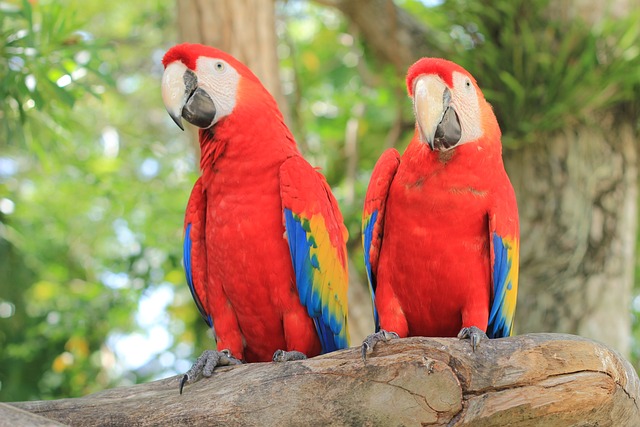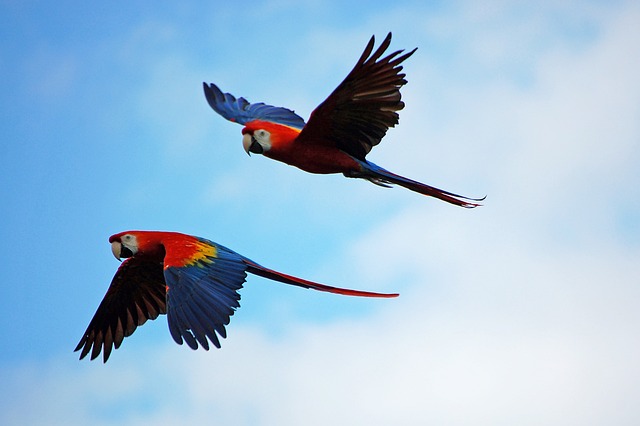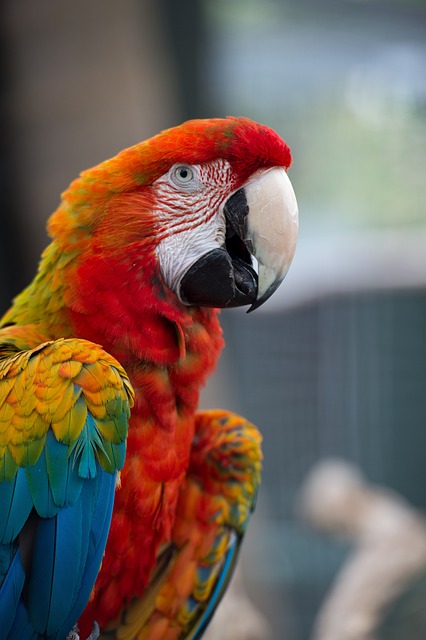Scarlet macaws are colorful and strikingly beautiful parrots known for their vibrant red plumage and their lively personalities. Here are 50 fascinating facts about Scarlet macaws:
Taxonomy and Classification:
Scientific Name: The scientific name for the Scarlet macaw is Ara macao.
Family: Scarlet macaws belong to the family Psittacidae, which includes parrots and macaws.
Physical Characteristics:
Size: Scarlet macaws are large parrots, measuring about 32 to 36 inches (81 to 91 cm) in length.
Weight: They typically weigh between 2 to 3 pounds (0.9 to 1.4 kilograms).
Plumage: Their most distinctive feature is their bright red plumage, which covers most of their body.
Wing and Tail Feathers: They have blue and yellow wing feathers and a long tail with a mix of blue and red feathers.
Face and Beak: The face of a Scarlet macaw is bare with bright white skin, and they have a strong, curved beak.
Eye Color: Their eyes are pale yellow to light orange in color.

Distribution:
Range: Scarlet macaws are native to the tropical rainforests of Central and South America, including countries like Mexico, Belize, Guatemala, Honduras, Costa Rica, Panama, Colombia, Ecuador, Venezuela, and Brazil.
Habitat: They are typically found in humid lowland forests, but they can also be seen in drier forests, savannas, and mangroves.
Diet:
Omnivorous: Scarlet macaws have an omnivorous diet, consisting of fruits, nuts, seeds, flowers, leaves, and occasionally insects and small vertebrates.
Beak Strength: Their powerful beaks allow them to crack open nuts and seeds with ease.
Conservation Status:
IUCN Status: The Scarlet macaw is classified as a species of “Least Concern” by the International Union for Conservation of Nature (IUCN), though some subspecies have more critical status.
Conservation Challenges: They face habitat loss, illegal pet trade, and hunting pressures in some regions, which affect certain populations more than others.
Life Span:
In the Wild: In the wild, Scarlet macaws can live for approximately 40 to 50 years.
In Captivity: In captivity, they may live longer, often reaching 75 years or more with proper care.
Social Behavior:
Flocking: Scarlet macaws are social birds and often form flocks of up to several dozen individuals.
Monogamous: They are known to form monogamous pairs that stay together for life.
Vocalization: They are noisy birds and communicate with loud calls and squawks.
Playful Nature: Scarlet macaws are known for their playful behavior, which includes hanging upside down and playing with objects.

Breeding and Nesting:
Nesting Sites: They typically nest in tree hollows or crevices in cliffs.
Eggs: Female Scarlet macaws usually lay two to four eggs in a clutch.
Incubation: Both the male and female take turns incubating the eggs and caring for the young.
Juvenile Plumage: Juvenile Scarlet macaws have duller plumage than adults and may lack the bright red coloration.
Flight:
Strong Fliers: Scarlet macaws are strong and agile fliers, capable of covering long distances.
Flying Pairs: They often fly in pairs or small groups while foraging.
Molt:
Feather Replacement: Scarlet macaws undergo a molt, during which they replace old feathers with new ones.
Predators:
Natural Predators: Predators of Scarlet macaws include large birds of prey and arboreal mammals like monkeys.
Intelligence:
High Intelligence: Like other parrot species, Scarlet macaws are intelligent birds with problem-solving abilities.
Mimicry: They have the capacity to mimic human speech and other sounds, though they are not as famous for this as some other parrot species.
Human Interaction:
Cultural Significance: Scarlet macaws have cultural significance among indigenous peoples in their native range.
Illegal Pet Trade: The pet trade has posed a significant threat to these birds, leading to conservation efforts to combat illegal capture and trade.
Conservation Efforts:
Protected Areas: Many protected areas and conservation initiatives aim to safeguard the Scarlet macaw’s habitat.
Release Programs: Some organizations have initiated release programs to reintroduce captive-bred Scarlet macaws into the wild.
Color Variations:
Subspecies: There are several subspecies of Scarlet macaws, with variations in coloration and range.
Thermoregulation:
Bare Face: The bare white skin on their face helps them dissipate excess heat.
Mating Rituals:
Display Behavior: During courtship, they engage in elaborate displays, which may include synchronized flying and vocalizations.
Territory Defense: They may defend their nesting territory fiercely against other potential intruders.
Flight Speed:
Flight Speed: Scarlet macaws can fly at speeds of up to 35 miles per hour (56 kilometers per hour).
Seed Dispersal:
Ecological Role: They play a vital role in the ecosystem by dispersing seeds of the fruits they consume.
Beak Use:
Tool for Manipulation: Scarlet macaws use their strong beaks not only for feeding but also for manipulating objects and climbing.

Feeding Adaptations:
Extracting Seeds: They are skilled at extracting seeds from fruits without eating the flesh.
Roosting:
Nighttime Roosts: They often roost in tree hollows or cliffs at night to avoid predators.
Parental Care:
Fledgling Care: Parental care continues even after the chicks fledge, as they teach them to fly and forage.
Social Grooming:
Mutual Grooming: They engage in mutual grooming with their mate, reinforcing social bonds.
Mobbing Behavior:
Defense Mechanism: Scarlet macaws may engage in mobbing behavior to drive away potential threats, such as predators or other birds.
Human Conflict:
Crop Damage: In some regions, they may be seen as pests due to their consumption of crops like maize and sunflowers.
Nesting Competitors:
Competition for Nest Sites: Scarlet macaws may compete for nesting sites with other birds, such as toucans.
Nesting Materials:
Collecting Nest Material: They gather leaves, sticks, and other materials to line their nests.
Conservation Partnerships:
Collaborative Conservation: Conservation organizations and local communities often work together to protect Scarlet macaws and their habitats through various initiatives.
